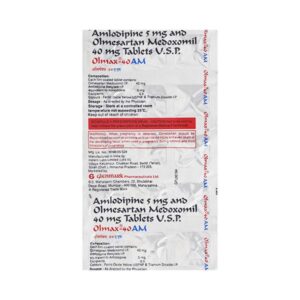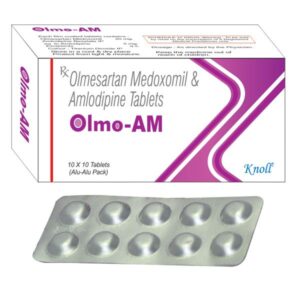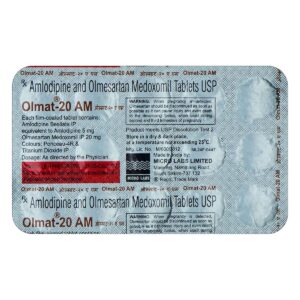AMLODIPINE + OLMESARTAN
Amlodipine: Amlodipine is a medication that falls under the category of calcium channel blockers. It is primarily prescribed for the treatment of high blood pressure (hypertension) and certain types of chest pain called angina.
The mechanism of action of amlodipine involves blocking the influx of calcium ions into the smooth muscle cells of the blood vessels and heart. By doing so, it relaxes and widens the blood vessels, which results in improved blood flow and reduced blood pressure. It also reduces the workload on the heart, thereby relieving chest pain and improving oxygen supply to the heart muscle.
A typical starting dose of amlodipine for hypertension is 5 mg once daily, which may be increased to a maximum dose of 10 mg per day if necessary. For angina, the recommended dose ranges from 5-10 mg once daily. However, the specific dosage and duration of treatment may vary based on individual factors, such as the severity of the condition and the patient’s response to the medication. It is essential to follow the instructions provided by the healthcare provider and not adjust the dose without medical advice.
Like any medication, amlodipine may cause side effects. Common side effects include:
1. Swelling in the ankles or feet
2. Flushing or feeling warm/hot
3. Dizziness or lightheadedness
4. Headache
5. Fatigue or tiredness
While these side effects are generally mild and temporary, it is important to inform a healthcare provider if they become severe or persistent. Rare but serious side effects may include a rapid heartbeat, chest pain, or allergic reactions such as rash, itching, or swelling.
It is crucial to discuss any existing medical conditions or medications with a healthcare provider before starting amlodipine, as certain conditions or drug interactions may require dose adjustments or alternate treatment options.
Olmesartan: Olmesartan is a medication that is commonly prescribed to treat high blood pressure (hypertension). It is sold under the brand name Benicar.
The drug belongs to a class of medications known as angiotensin II receptor blockers (ARBs). It works by blocking the action of a hormone called angiotensin II, which causes blood vessels to narrow. By blocking the effects of angiotensin II, Olmesartan helps to relax and widen the blood vessels, thereby reducing blood pressure.
The usual starting dose of Olmesartan for adults is 20mg once daily. The dose may be increased to a maximum of 40mg daily if blood pressure remains high. For pediatric patients 6-16 years old, the starting and maximum dose is 10mg once daily.
Common side effects of Olmesartan may include dizziness, diarrhea, stomach pain, back pain, respiratory tract infections, and headache. It is important to note that these side effects are not experienced by everyone and may vary in severity. In rare cases, Olmesartan can cause a severe allergic reaction, which may include swelling of the face, lips, tongue, or throat, difficulty breathing, or hives. If any severe side effects occur, medical attention should be sought immediately.
Olmesartan is typically used as a long-term treatment for high blood pressure. It is important to take the medication consistently and as directed by a healthcare provider. It may take several weeks for the full effects of Olmesartan to be felt, so it is crucial not to stop taking the medication abruptly without consulting a healthcare professional.



